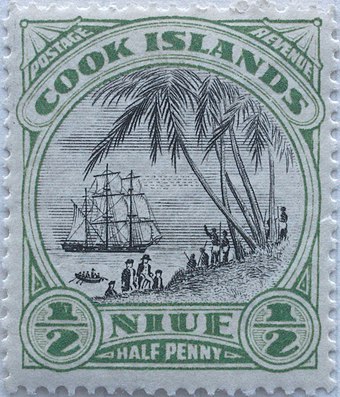Polynesians from Samoa settled Niue around 900 AD. Further settlers arrived from Tonga in the 16th century.[22]
Until the beginning of the 18th century, Niue appears to have had no national government or national leader; chiefs and heads of families exercised authority over segments of the population. A succession of patu-iki (kings) ruled, beginning with Puni-mata. Tui-toga, who reigned from 1875 to 1887, was the first Christian king.[23]

The first Europeans to sight Niue sailed under Captain James Cook in 1774. Cook made three attempts to land, but the inhabitants refused to grant permission to do so. He named the island “Savage Island” because, as legend has it, the natives who “greeted” him were painted in what appeared to be blood. The substance on their teeth was hulahula, a native red fe’i banana.[24] For the next couple of centuries, Niue was known as Savage Island until its original name, “Niue”, which translates as “behold the coconut”,[25] regained use.
Whaling vessels were some of the most regular visitors to the island in the nineteenth century. The first on record was the Fanny in February 1824. The last known whaler to visit was the Albatross in November 1899.[26]
The next notable European visitors represented the London Missionary Society; they arrived on the Messenger of Peace. After many years of trying to land a European missionary, they abducted a Niuean named Nukai Peniamina and trained him as a pastor at the Malua Theological College in Samoa.[27] Peniamina returned in 1846 on the John Williams as a missionary with the help of Toimata Fakafitifonua. He was finally allowed to land in Uluvehi Mutalau after a number of attempts in other villages had failed. The chiefs of Mutalau village allowed him to land and assigned over 60 warriors to protect him day and night at the fort in Fupiu.
Prime Minister of New Zealand Richard Seddon and the King of Niue, circa 1900
In July 1849 Captain John Erskine visited the island in HMS Havannah.[28]
Christianity was first taught to the Mutalau people before it spread to all the villages. Originally other major villages opposed the introduction of Christianity and had sought to kill Peniamina. The people from the village of Hakupu, although the last village to receive Christianity, came and asked for a “word of God”; hence, their village was renamed “Ha Kupu Atua” meaning “any word of God”, or “Hakupu” for short.
In 1889 the chiefs and rulers of Niue, in a letter to Queen Victoria, asked her “to stretch out towards us your mighty hand, that Niue may hide herself in it and be safe”.[29] After expressing anxiety lest some other nation should take possession of the island, the letter continued: “We leave it with you to do as seems best to you. If you send the flag of Britain that is well; or if you send a Commissioner to reside among us, that will be well”.[29] The British did not initially take up the offer. In 1900 a petition by the Cook Islanders asking for annexation included Niue “if possible”.[29] In a document dated 19 October 1900, the “King” and Chiefs of Niue consented to “Queen Victoria taking possession of this island”. A despatch to the Secretary of State for the Colonies from the Governor of New Zealand referred to the views expressed by the Chiefs in favor of “annexation” and to this document as “the deed of cession”. A British Protectorate was declared, but it remained short-lived. Niue was brought within the boundaries of New Zealand on 11 June 1901 by the same Order and Proclamation as the Cook Islands. The Order limited the islands to which it related by reference to an area in the Pacific described by coordinates, and Niue, at 19.02 S., 169.55 W, lies within that area.[29]
The New Zealand Parliament restored self-government in Niue with the 1974 constitution, following a referendum in 1974 in which Niueans had three options: independence, self-government or continuation as a New Zealand territory. The majority selected self-government and Niue’s written constitution[30] was promulgated as supreme law. Robert Rex, ethnically part European, part native, was elected by the Niue Assembly as the first premier, a position he held until his death 18 years later. Rex became the first Niuean to receive a knighthood – in 1984.
In January 2004 Cyclone Heta hit Niue, killing two people and causing extensive damage to the entire island, including wiping out most of the south of the capital, Alofi.
On March 7, 2020, the International Dark Sky Association announced that Niue had become the first Dark Sky Preserve Nation.[31] On 29 September 2022, President Joe Biden announced that the United States would recognize Niue as a sovereign nation.[32]
Leave a Reply